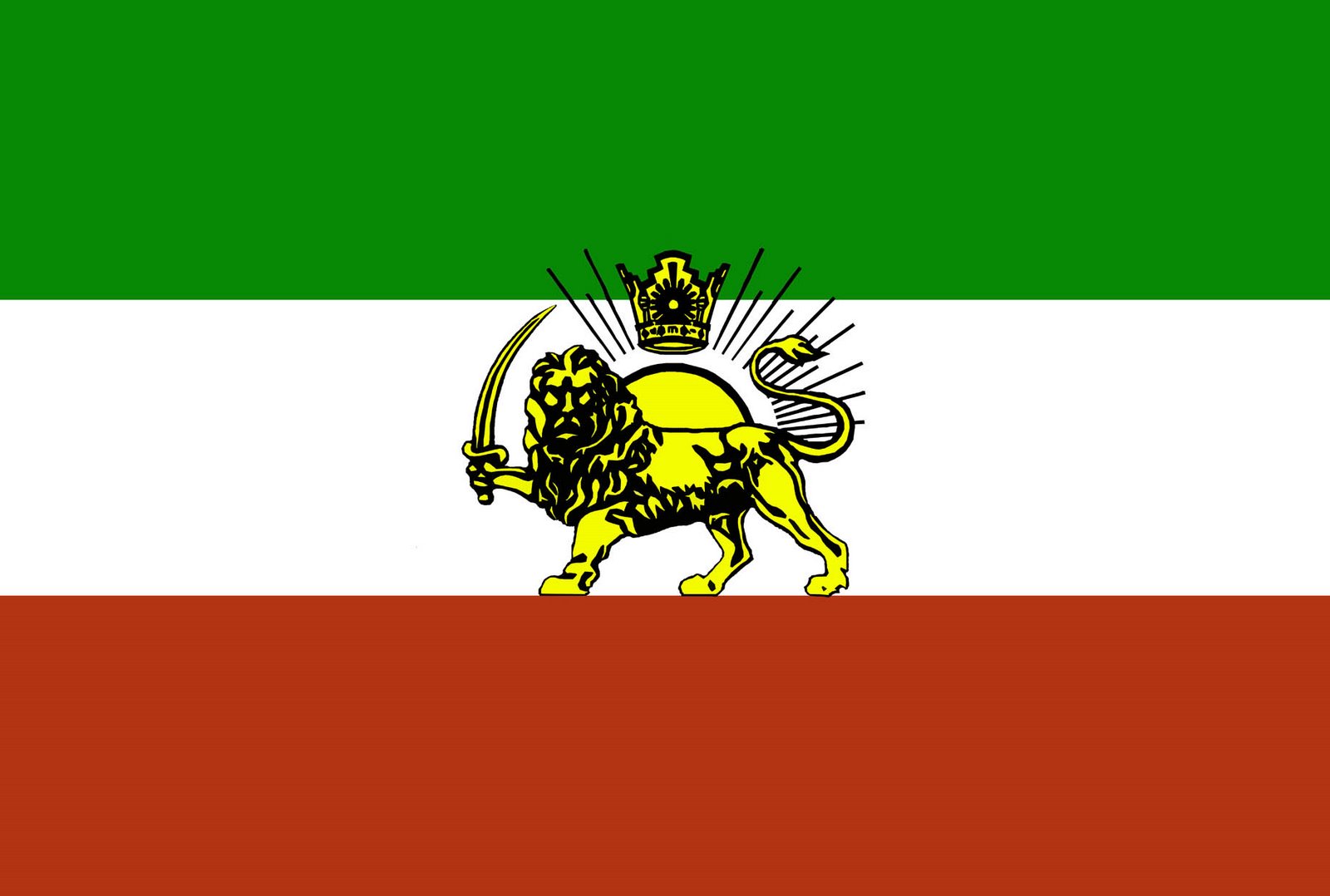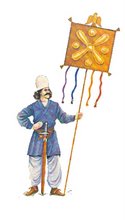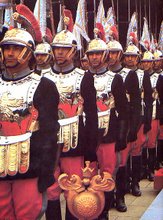The Bloodstained Hands of Iran’s Leftist Intellectuals and Fedayeen Guerrillas
By Manuchehr Yazdi (Pan-Iranist Party)
Nimrooz.com
April 16, 2004
Source Link
Previously in our journal, People’s Government (Pan-Iranist Party), we gave a brief account of the Tudeh Party (Communist) and the communist movement in Iran, noting their crimes and treason during Iran’s occupation by the Allies, and the perilous years when the people of Iran grappled with the pressures exerted by foreign states. We related how the educated and intellectual members of the Tudeh Party and of the Left added to the suffering of the people of Iran, and how they managed to push the nation to the brink of annexation and breakup.
To continue, from 1970 on, with the beginning of the Shah’s struggle against the oil consortiums, as the onslaught of British and Russian policies, along with those of certain Arab states such as Egypt and Iraq, targeted Iran’s interests and resources, beating the drums for the annexation of Khuzestan, Bahrain and the Arvand River…political opposition in Iran transformed into terrorism and urban warfare. The first political organization that under such dangerous conditions resorted to appealing to a foreign state, namely to Egypt’s Jamal Abdel-Nasser, to provide its dissatisfied members with military and terrorist training was the “Nehzate Azadi” Organization, which we shall discuss later. It was at this time that two terrorist movements simultaneously made their appearance. One emerged from the belly of the Tudeh Party and was named “The Iranian People’s Fadayee Guerrillas”; the other emerged from Nehzate Azadi and was named “The Iranian People’s Mujahedin”.
The founder of Fadayeen (literally meaning those sacrificing themselves) was Bijan Jazani. He was the son of Rahmatullah Jazani, a famous communist and Tudeh Party member who had escaped to the Soviet Union. Bijan’s mother was a Jew who had abandoned his son and gone to live in Israel. Bijan felt this abandonment by his parents in every cell of his body. He married Mahin Ghoreishi, a Marxist militant, transforming her into a capable intelligence operative.
Bijan Jazani was a well-read, educated young man whose psychological frustrations veered him away from national loyalty towards an illusion. He owned an advertising agency called “Tabli Film” from which he profited greatly, owned a modern home and enjoyed a comfortable life. Eventually, after years of secret activity, the educated, intellectual and charming Bijan founded the organization with the help of three of his friends: Hassan Zia Zarifi, Jalili-Afshar and Kalantari (brother of Manuchehr Kalantari, one of the leaders of the “Confederation of Iranian Students” in London). But Iran’s counterintelligence and security service, cognizant of activities of anti-Iranian organizations and in control of the internal situation, infiltrated two of their cells, putting two of their safe-houses, one serving as a weapons depot, under surveillance. Under watch in a meeting on Malek Street to pick up weapons, he was surrounded and arrested as he drove away in his Volkswagen, in which several firearms were found. Two of Bijan’s collaborators mentioned above were also later arrested and the three were charged with armed activities and forming a Marxist organization. Although according to existing laws and based on their own confessions they threatened Iran’s national security, in the “fascist regime” (according to certain intellectuals) of the time they were sentenced to 15 years in prison.
They were transferred from Tehran’s prison to the city of Rasht, where they met with Hamid Ashraf, Hamid Sadeghinezhad and Amir Parviz Pooyan, and planned a new strategy to continue their war. During these meetings the organization became active once more, this time operating as two teams: One based in the city and another operating in the jungles. The latter, under the command of Ali Akbar Safa’i Farahani, stockpiled equipment and supplies in the jungles of Siah-kal. The city-based team had the task of finding new safe houses and recruiting new members, looking particularly for those coming to Iran with terrorist training in Palestine or elsewhere.
Soon a member of the jungle-based team by the name of Iraj Neyri came under the suspicion of the local villagers, seized and turned over to the Gendarmerie. To rescue their comrade the jungle team resorted to an armed attack on the Gendarmerie post where Neyri was held. The operation was led by Safa’i Farahani, a secretary of Tehran’s Art Institute, trained in terrorist operations and guerrilla warfare under Yasir Arafat, holding the rank of a “captain” and generally known as “Abu Abbass”. This young, educated teacher had trained in an Arab terrorist camp to open fire on Iranians, to the benefit of oil companies, foreign powers and international communists. One communist and a number of Gendarmes were killed in the attack, the rest of the guerrillas took flight but the assailants failed to rescue Neyri.
With the arrest of Iraj Neyri the urban cell was soon discovered and disbanded, and many of its members were put under arrest. Although the organization was thus virtually destroyed, nevertheless with the help of Amir Parviz Pooyan, Mohammad Ali Partowi, Mohammad Saffari Ashtiani and Eskandar Sadeghinezhad a year later it became active once more, once more setting in motion more terrorist acts, explosions and murders.
In following this anti-people path, the interests of the people of Iran were never taken into consideration. The militants would commit any crime to set Iran aflame. One such barbaric act, which fortunately did not succeed, was the plan to blow up a one hundred thousand-seat stadium during the Asian Games in Tehran. In a show of unity, and in order to embarrass the Iranian government, terrorist groups had decided to use this opportunity of brandishing Iran a disorderly state to the fullest extent. This is how the plan was foiled:
The counterintelligence unit of Imperial Iranian Air Force, having become suspicious of an officer by the name of Mohammad Baradaran Khosroshahi, reports him to Iran’s counterintelligence and internal security service (Savak) for surveillance. The pursuit and observation of this officer proves rewarding and he along with six others is arrested in a safe house in Salsabil. The confessions obtained from these individuals revealed the names of some 70 members of the Fedayeen, all of whom were soon arrested. One of these worked in the office of Mehdi Bazargan (the republic’s, and Ayatullah Khomeini’s, first Islamic Prime Minister), but it was another, Iraj Khalaf-Beigi, who informed on the horrendous plot to blow up the stadium, revealing the name of Habib Baradaran Khosroshahi as the brain behind the operation.
Habib Baradaran Khosroshahi was a high level employee of the Department of Physical Education and personally responsible for the management of sports stadiums. He told of the plan to place numerous bombs under the seats of spectators and even revealed their exact location. The watchfulness of authorities, day and night, prevented the massacre of at least 5000 people in this terrorist operation and revealed the real nature, an the true color, of these educated, intellectual militant gentlemen, the lovers of the oppressed and the exploited “worker”.
But Habib Khosroshahi, whose 400 page testimony had effectively demolished the organization, announced to have a meeting with Hamid Ashraf and asked the authorities to take him to the appointed place. Hamid Ashraf, who until then had murdered 13 people and was sought by the police, was considered a top priority and so Khosroshahi’s proposal was met with approval. They took him to the place of meeting, near an intersection, and had no choice but to distance themselves from the scene. Taking advantage of the opportunity Hamid threw himself under the wheels of a bus and committed suicide. His incriminating confession had rendered him a worthless agent. No longer able to play the role of the militant intellectual, he chose to play the martyr. In fact, his decision proved advantageous and the “The Iranian People’s Fadayee Guerrillas” later claimed that Habib Khosroshahi had been “martyred under torture!”
Another difficulty connected with the Asian Games in Tehran was the presence of Israeli athletes who had to be specially protected to prevent a repetition of the Munich massacre. And so their arrival time was first announced to be 5 p.m., followed by “10 o’clock at night”, to be followed by yet another announcement that they would arrive the following day! Actually, Israeli athletes had entered Tehran 24 hours prior to the first announcement and were resting peacefully as these announcements were broadcasted!
During the period when Hamid Ashraf was the leader of the Fedayeen, 14 safe houses had been set up and Ms. Nastaran Alagha had the responsibility of managing them. These houses were full of educated, worldly, well-trained, dedicated young men and women who believed that in order to serve oppressed people one must carry grenades in one’s pocket, a machine gun in one’s hand and a cyanide capsule in one’s mouth. These militants did not realize they were merely tools in paving the way for the destruction of Iran. Iran’s Savak soon discovered these houses and laid the necessary plans to raid them. The safe house in which Hamid Ashraf lived was located in the capital’s New Tehran district. After surrounding the house, security agents used loud speakers to tell those inside of their situation. Moments later heavy smoke was seen coming out of the house, a sign that documents were being burned. This was followed by the sound of two shots and Hamid Ashraf, under the protection of his friends’ fire, managed to get away with an injured leg. The rest of the team was killed in the battle.
After the gunfight, upon entering the house the agents observed the corpses of two children. They were the nine-year-old Naser Shaygan Shamasbi and the twelve-year-old Arzhang Shaygan Shamasbi. They had been shot in the head and executed. It was later revealed that Hamid Ashraf had executed the two children before taking flight to prevent them from describing what they had witnessed.
Having escaped at 5-6 o’clock in the morning, Hamid Ashraf went to another safe house in Ghasem Abad, but finding the place insecure he left the place at 9 in the morning. By accident he was approached by a police car, carrying an officer, two intelligence agents and the driver. As they were not on the case, the passengers did not recognize Ashraf. Ashraf opened fire on the passengers, killing all four, and took off with the police car killing a colonel on Mohseni Square on the way. Thus during only a few hours, the leader of intellectual militants “of Iranian people” had murdered six innocent people. On June 29, 1976, during a meeting in a safe house in yet another part of Tehran, Iran’s security agents surrounded Ashraf and ten highest-ranking members of the organization. The “rebels” opened fire and in the bloody battle which pursued all met their deaths. Hamid Ashraf, the leader of the organization, had managed to get away from the scene as before but was killed, while running on a roof, with a bullet to the head.
With the death of its leader, highest-ranking members, plus those killed in these battles and the arrest of everyone else, the organization was effectively destroyed. Only six or so members remained who, no sooner having been released under the administrations of Sharif-Emami and Shahpour Bakhtiar, each became the leader of a new group and added fuel to the ferocious flames of the Islamic Revolution.
The information here was compiled from newspapers published during the first years of the revolution, particularly from notices and inserts in Keyhan and Etela’at. During those honeymoon days of the revolution, proclamations by the organization itself (for it was launched once more), letters by the parents of the killed militants and the confessions of surviving militants are all authentic documents testifying to the deeds of those educated and intellectual individuals who played an important role in the downfall of the Iranian government, and the bringing to power of the Islamic regime…for which they received their due pay.
------------------------------
The groups mentioned above remain active to this date and are considered, by some naive Iranians who have not understood the nature of these organizations, as part of the opposition. This article has been posted here mainly for their benefit.
The websites of these organizations:
---Nehzate Azadi ("Freedom Movement")
http://www.nehzateazadi.org/english/history.htm
---The Organisation of Iranian People's Fedayeen
http://siahkal.com/home.htm
http://www.fadai.org/
http://www.geocities.com/~fedaian/










No comments:
Post a Comment